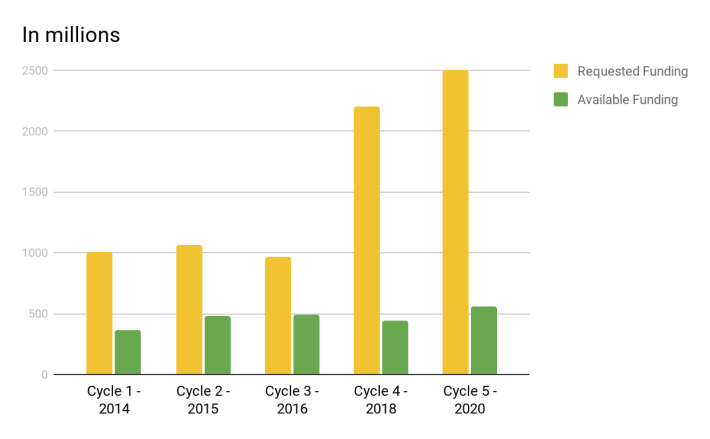In California, the basic needs of life--safety, security, dignity--are growing further out of reach for entirely too many people. So, too, is the state’s largest grant program to make streets safer for all of us, the Active Transportation Program (ATP). Like basic human needs, the needs to slow speeds, increase access, and save lives are increasingly going unmet.
Created in 2013, the ATP combined a number of different funding sources for bicycle, pedestrian, and Safe Routes to School projects into one big pot of money. That left projects from small town plans to big-dollar Complete Streets transformations competing for a slice of the same pie. And while the amount of ATP funding has grown over time, so has the need for that funding. The ATP is thoroughly oversubscribed and unable to meet the state’s needs without considerably more support from Sacramento.
In 2020, just 64 projects were submitted to the ATP, from fewer than half of the 89 municipalities in and including Los Angeles County. Of course, those projects don’t begin to cover the region’s vast transportation needs, but many public agencies and advocates know their chances are slim in the ever more competitive ATP, finding that it’s no longer worth the time and expense needed for a winning application. Plenty are simply tired of rejection.
In 2014, cities and counties across the state requested about $1 billion in funding for pedestrian and bicycle safety projects, but there was only $368 million available, meaning about 37 percent of applicants were funded that cycle. Fast forward to Cycle 5 in 2020 when over $2.5 billion in funding requests were submitted for $554 million in available funding, a success rate of about 22 percent. In Los Angeles County, only 14 of 64 applications were awarded even partial funding, or 22 percent total - demoralizing, yet consistent with the statewide average.
The funds are scarce, but the stakes are high. Traffic crashes are the number one cause of premature death in Los Angeles County for children aged 5-14, and the number two cause for children 1-4, young adults 15-24, and adults 25-44, according to the Department of Public Health. Nationally, traffic collisions continue to cost the lives of an estimated 40,000 Americans every year. Despite this clear and seemingly endless public health crisis, less than one percent of our state transportation dollars go to improving safety for our most vulnerable road users.
In comparison, Los Angeles County’s commitments to active transportation have been similarly underwhelming. When developing its two historic ballot measures in 2008 (Measure R) and 2016 (Measure M), Los Angeles Metro only set aside funding for active transportation in the latter, despite so many high-injury streets across the region. Even then, only a paltry two percent of Measure M's massive projected revenue was earmarked for things like safer sidewalks, crosswalks, and bikeways; this money was reserved entirely for “first-last mile” projects and extending the Los Angeles River Bike Path.
This systemic failure is not lost on advocates around the state, who are struggling to deal with a network of roads that are dangerous by design. A coalition of over two dozen safety, health, and climate organizations, including the Safe Routes National Partnership, California Walks, California Bicycle Coalition, Climate Plan, and the Coalition for Clean Air, have formally urged state legislators to dedicate a portion of California’s record budget surplus to funding every 2020 ATP application that received at least 80 of 100 total points. The 2020 cutoff was a record high score of 92, leaving many otherwise meritorious and potentially life-saving projects unfunded.
The $500 million augment for this purpose in Governor Newsom’s May Revise is a good start, and we urge our state legislators to invest in the health and safety of our communities through this one-time fix to the ATP. At a minimum, any community that successfully navigates the gauntlet that is the ATP application -- a process requiring hundreds of hours of staff and community time -- and earns what is essentially a “B” grade deserves to be funded.
However, even with the proposed augmentation to meet this year’s demand, we cannot forget that fundamentally the outcomes on our streets, and even the incredible challenge of today’s ATP, are the result of conscious choices and decades of policymaking that has placed the needs of our most vulnerable dead last.
Until we align our public safety, public health, and climate goals with our regular, planned transportation spending, we will continue to deal with lives needlessly cut short and some of the worst air quality in the United States. A program that only awards funding to eight of 88 cities in the largest county in the largest state in the U.S., once every two years, is hardly a model program. Securing a state grant to make your street a little bit safer should not be harder than getting into UCSD. Let’s make a downpayment on June 15, and then commit to realizing healthier, more vibrant and sustainable cities as a matter of course by 2030.
Wesley Reutimann is Special Programs Director and co-founder of the Pasadena Complete Streets Coalition and ActiveSGV, a community-based, non-profit organization committed to realizing a more sustainable, equitable, and livable San Gabriel Valley. Wesley has over a decade of experience in the non-profit, public health, and government sectors, with a specific focus on the built environment, sustainability, and healthy communities.








